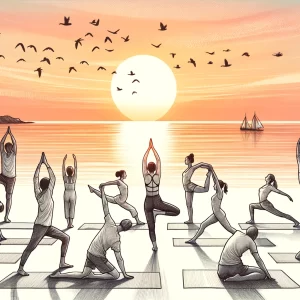All Standing Yoga Poses With Names
Here is a list of all standing yoga poses with their names. This list is intended for informational purposes only. Please consult with a qualified yoga instructor before practicing any of these poses.
1. Mountain Pose (Tadasana)
2. Standing Forward Fold (Uttanasana)
3. Standing Half Forward Fold (Ardha Uttanasana)
4. Standing Separate Leg Forward Fold (Prasarita Padottanasana)
5. Warrior I Pose (Virabhadrasana I)
6. Warrior II Pose (Virabhadrasana II)
7. Warrior III Pose (Virabhadrasana III)
8. Triangle Pose (Trikonasana)
9. Extended Side Angle Pose (Utthita Parsvakonasana)
10. Reverse Warrior Pose (Parsva Bakasana)
11. Downward-Facing Dog Pose (Adho Mukha Svanasana)
12. Upward-Facing Dog Pose (Urdhva Mukha Svanasana)
13. Plank Pose (Chaturanga Dandasana)
14. Forearm Plank Pose (Padahastasana)
15. Chaturanga Dandasana with One Leg Raised (Eka Pada Koundinyasana)
16. Crow Pose (Bakasana)
17. Locust Pose (Salabhasana)
18. Bridge Pose (Setu Bandhasana)
19. Wheel Pose (Urdhva Dhanurasana)
20. Camel Pose (Ustrasana)
Standing Yoga Poses for Beginners
Standing yoga poses are a great way for beginners to get started with yoga. They are relatively easy to do, and they can help to improve your balance, flexibility, and strength.
Here are some standing yoga poses for beginners:
* Mountain Pose (Tadasana)
* Standing Forward Fold (Uttanasana)
* Standing Half Forward Fold (Ardha Uttanasana)
* Standing Side Bend (Virabhadrasana I)
* Warrior II Pose (Virabhadrasana II)
* Tree Pose (Vrksasana)
* Crescent Lunge (Anjaneyasana)
* Half Moon Pose (Ardha Chandrasana)
* Standing Bow Pose (Dhanurasana)
These poses are all great for beginners, and they can be modified to make them more or less challenging. If you are new to yoga, start by practicing these poses for a few minutes each day. As you get stronger and more flexible, you can gradually increase the length of your practice.
Be sure to listen to your body and stop if you feel any pain. Yoga is meant to be a relaxing and enjoyable experience, so don’t push yourself too hard.
If you have any concerns about starting a yoga practice, talk to your doctor before you begin.
Standing Yoga Poses for Flexibility
Standing yoga poses are a great way to improve your flexibility. They stretch your hamstrings, calves, groin, and hips, and can help you achieve a greater range of motion in these areas. Some of the most popular standing yoga poses for flexibility include:
- Standing Forward Fold
- High Lunge
- Warrior II
- Pigeon Pose
- Downward Dog
When practicing these poses, it is important to listen to your body and not push yourself too hard. If you feel any pain, stop and modify the pose as needed.
Standing yoga poses for flexibility can be practiced as part of a regular yoga practice, or they can be done on their own as a way to improve your flexibility and range of motion.
Standing Yoga Poses for Back Pain
Standing yoga poses can be a great way to relieve back pain. When you’re standing, your body is in a natural alignment, which can help to reduce strain on your back. Standing poses also help to strengthen your core muscles, which can support your spine and help to prevent back pain.
Here are some standing yoga poses that are specifically helpful for relieving back pain:
* **Mountain Pose** (Tadasana): Stand with your feet shoulder-width apart and your arms at your sides. Inhale and raise your arms overhead, then exhale and lower them back to your sides. Repeat this 5-10 times.
* **Standing Forward Fold** (Uttanasana): Stand with your feet together and your arms at your sides. Inhale and reach your arms up overhead, then exhale and fold forward at your hips, keeping your legs straight. You can rest your hands on your shins or ankles, or you can reach your fingertips toward the ground. Hold this pose for 30-60 seconds, then inhale and come back to standing.
* **Warrior II Pose** (Virabhadrasana II): Stand with your feet wide apart, and step your right foot forward so that your right knee is bent 90 degrees and your left leg is straight. Extend your arms out to the sides at shoulder height, and turn your head to look over your right shoulder. Hold this pose for 30-60 seconds, then switch sides.
* **Half Moon Pose** (Ardha Chandrasana): Stand with your feet together and your arms at your sides. Inhale and step your right foot forward so that your right knee is bent 90 degrees and your left leg is straight. Extend your arms out to the sides at shoulder height, and reach your left arm up overhead. Keep your right knee aligned with your ankle, and do not allow your left hip to sag. Hold this pose for 30-60 seconds, then switch sides.
* **Bridge Pose** (Setu Bandhasana): Lie on your back with your knees bent and your feet flat on the floor. Place your hands on your hips, and inhale as you lift your hips off the floor. Keep your shoulders relaxed and your feet hip-width apart. Hold this pose for 30-60 seconds, then lower back down to the floor.
These are just a few of the many standing yoga poses that can help to relieve back pain. If you’re experiencing back pain, talk to your doctor about whether yoga is right for you.
V. Standing Yoga Poses for Back Pain
Standing yoga poses can be a great way to relieve back pain. They can help to stretch and strengthen the muscles in your back, and they can also improve your posture. Some of the best standing yoga poses for back pain include:
- Warrior I pose
- Warrior II pose
- Extended Side Angle pose
- Downward-Facing Dog pose
- Child’s pose
When you’re doing these poses, be sure to listen to your body and stop if you feel any pain. You can also modify the poses as needed to make them more comfortable.
If you have chronic back pain, it’s a good idea to talk to your doctor before starting a yoga practice. They can help you determine which poses are right for you and how to safely incorporate them into your routine.


